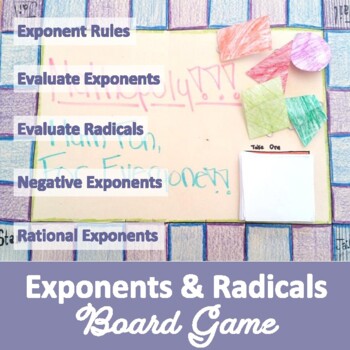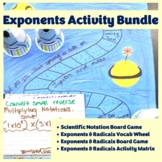Exponents & Radicals Board Game - Project Based Learning (PBL) with Math
- PDF
What educators are saying
Also included in
- Engagement soars as students create original products to test their skills with exponents, radicals, scientific notation, exponential vocabulary! Immerse your students in a world of creativity with these four imaginative assignments.These student-centered activities encourage your students to thinkPrice $8.00Original Price $12.00Save $4.00
Description
Awaken your students’ innovative spirit while creating their own board game! Engagement soars as they create original game questions to evaluate exponents and radicals, address the five exponent rules, and test their skills with negative or rational exponents.
This student-led activity allows your pupils to get creative with their project theme as they turn everyday classroom items into an interactive game. As enjoyment increases, so does learning. Prepare to be impressed!
Students will:
- Design a game board, game pieces, and game rules
- Create exponent and radical questions for game play
- Create a solution key
- Play a game that their peers have created
You will love the easy prep … just provide copies, a file folder, and classroom art supplies like paper and colored markers. This product offers great flexibility. Choose to spend two days doing the entire project or add one part of the project to your daily lesson for a week.
Your students will love the collaborative environment. As students work together, they will enjoy mathematical discussion and find imaginative solutions. Creativity and collaboration lead to greater success. It’s a win-win!
Downloads included with this resource:
- Instructions for Teachers
- Instructions for Students
- Grading Rubric
- Student Samples
Students use creativity to demonstrate mastery with operations involving exponents and radicals. The Exponents & Radicals Board Game gives students the opportunity to create a wholly original game that incorporates: evaluating exponents, evaluating radicals, negative exponents, fractional exponents, and the exponent rules. Students must write the instructions for the game, create game pieces and determine how those pieces move around the board (spinner, dice, etc.).
**************************************************************************************************
What other teachers are saying …
“Love what my students created! It gave enough information for them to apply their knowledge in a creative and fun way. Thank you.” - Nora M.
“I used this as a project for my students to create a radical review game. I took the advice from the seller and had students play these in class before I took them up to grade them. Students were very creative and it was easy to see who had put forth effort and who had not. Overall it was a huge success and students found their mistakes during the playing of the games, which was an awesome review before their test.” - Syrena C.
“Great idea. I liked having it on the folders so it was all in one spot.” -Melissa S.
**************************************************************************************************
Other products from Absolute Value you may enjoy….
Exponents & Radicals Activities Project
Exponents & Radicals Vocabulary Wheel
Fun with Exponents Activity Bundle
****************************************************************************************************
Customer Tips: How to get TPT credit for future purchases:
Go to your “My Purchases” page. Next to each purchase, you'll see a “Provide Feedback” button. Simply click it and you will be taken to a page where you can give a quick rating and leave a short comment for the product. Each time you give feedback, TPT gives you feedback credits that you may use to lower the cost of your future purchases. We'd really love it if you'd rate our item after downloading! Feedback is so VERY important!
**************************************************************************************************
Follow my Store
Click on the green star next to my store logo to receive upcoming sales, freebie and product launches, and email updates!
Here's to a successful year!
Absolute Value
Petty415@gmail.com
For more Project Based Learning with Mathematics available at my store: https://www.teacherspayteachers.com/Store/Absolute-Value. This project was created and provided by Absolute Value.






